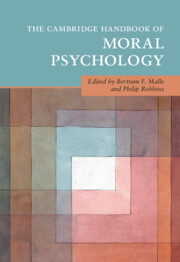Book contents
- The Cambridge Handbook of Moral Psychology
- Cambridge Handbooks in Psychology
- The Cambridge Handbook of Moral Psychology
- Copyright page
- Contents
- Figures
- Tables
- Contributors
- Preface
- 1 Modern Moral Psychology
- Part I Building Blocks
- Part II Thinking and Feeling
- Part III Behavior
- Part IV Origins, Development, and Variation
- Part V Applications and Extensions
- 21 Criminal Law, Intuitive Blame, and Moral Character
- 22 Moral Dimensions of Political Attitudes and Behavior
- 23 Moral and Religious Systems
- 24 Lessons from Moral Psychology for Moral Philosophy
- Index
- References
21 - Criminal Law, Intuitive Blame, and Moral Character
from Part V - Applications and Extensions
Published online by Cambridge University Press: 20 February 2025
- The Cambridge Handbook of Moral Psychology
- Cambridge Handbooks in Psychology
- The Cambridge Handbook of Moral Psychology
- Copyright page
- Contents
- Figures
- Tables
- Contributors
- Preface
- 1 Modern Moral Psychology
- Part I Building Blocks
- Part II Thinking and Feeling
- Part III Behavior
- Part IV Origins, Development, and Variation
- Part V Applications and Extensions
- 21 Criminal Law, Intuitive Blame, and Moral Character
- 22 Moral Dimensions of Political Attitudes and Behavior
- 23 Moral and Religious Systems
- 24 Lessons from Moral Psychology for Moral Philosophy
- Index
- References
Summary
This chapter of the handbook examines the sanctioning doctrines within Anglo-American criminal law and explores similarities and differences between criminal blame and ordinary social blame. The chapter explores the legal notion of actus reus in the context of intended but incomplete transgressive conduct, the distinction between intended and unintended outcomes, as well as questions of recklessness and the role of a transgressor’s character in ordinary and legal blame. It also explores the possibility that a fundamental human motivation to punish those with bad character can influence perceptions of legal questions such as consciousness of risk. Intuitions about the role of moral character in legal blame have produced legal rules restricting the consideration of prior misdeeds. At the same time, these rules and their interpretation ultimately rest on political and moral judgments, rather than psychological insights. The chapter concludes by briefly exploring some remaining questions of criminal law and intuitive blame, such as the role of cultural commitments on motivations to impose legal blame.
- Type
- Chapter
- Information
- The Cambridge Handbook of Moral Psychology , pp. 523 - 548Publisher: Cambridge University PressPrint publication year: 2025

